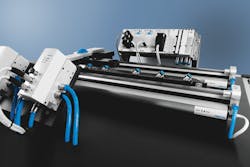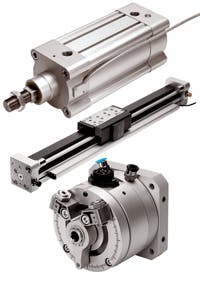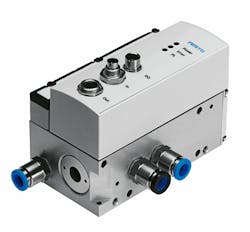Servoactuators that run on air
This file type includes high resolution graphics and schematics.
Designers of motion systems that handle low to moderate loads often consider only a couple drive alternatives: economical pneumatics for repetitive back-and-forth movements and electromechanical actuators for exacting control and multiposition capabilities. To that list, engineers need to add a third option: servopneumatics.
In suitable applications, servopneumatics improves motion-system performance while lowering overall costs. Compared with traditional pneumatics, where a linear or rotary actuator only stops when it’s fully extended or fully retracted, servopneumatic actuators permit wide variations in position, force, and velocity. And servopneumatics delivers the same flexibility as electromechanical-based servos, but with higher power densities.
First commercialized in the 1990s, early servopneumatic motion systems were looked on more as technical novelties rather than industrial workhorses. But over the last two decades, engineering advances — particularly involving control algorithms and microprocessors — have made servopneumatics a practical alternative for precisely controlling a variety of linear and rotary actuators. Today, they’re used in settings ranging from sawmills and sheet-metal handling operations to liquid-dosing equipment and package-labeling applications.
Servopneumatic basics
A basic servopneumatic system consists of an actuator with integrated feedback (encoder/potentiometer or other position-sensing element), a proportional valve, and a controller.
What differentiates these systems from standard pneumatics is that servopneumatics uses closed-loop positioning which, therefore, lets them perform like conventional electric servosystems.
In addition to the valve being proportional, a requirement for position and speed control, built-in sensors provide feedback on the pressure and, therefore, force. This permits force control.
The controller uses sophisticated, tried-and-tested algorithms that take into account variations in valve linearity, actuator orientation and friction, and the compressibility of air to provide accurate positioning and force control. For example, Festo servopneumatic systems offer positioning accuracies on the order of ±0.2 mm.
A wide range of actuator speeds and output forces is also possible. The flow rate of Festo’s VPWP 5/3 way proportional valve, for instance, ranges from 350 to 2,000 lpm. This is on par with the company’s other valves. It lets servosystems move horizontal loads of up to 1,300 kg and vertical loads to 1,100 kg. Travel speeds can reach 3 m/sec with maximum acceleration of 30 m/sec2.
Unlike basic valves, however, the VPWP has diagnostic capabilities, integrated pressure sensors, and a proprietary CANbus that handles communications with the controller and feedback data from the actuators. In addition, VPWP valves also generate a digital output that can actuate clamping devices.
Available options
Don’t try DIYOn occasion, engineers will assemble high-end hardware components together with a closed-loop controller in an attempt to build a “do-it-yourself” servopneumatic system. We’ve seen cases where many man-hours and considerable expense have been invested in components, configuration, and tuning — with mediocre results. The fact is, the challenges of designing and building a high-performance servopneumatic system lie not simply in the hardware components. Engineers must also have the right control algorithms and understand how every element interacts. Experienced companies like Festo have perfected this technology over the years. Purchasing a complete tried-and-tested system comprising components, controls, and software from a single supplier certainly has its advantages — including reduced engineering time and costs, superior positioning performance, and, last but not least, service and support from experts in this technology. |
Servopneumatic actuators fall into three primary categories:
- Piston rod cylinder.
- Rodless linear actuator.
- Rotary drive.
For example, Festo’s servopneumatic offerings include:
Standard, ISO 15552 rod-type cylinders in bore sizes from 32 to 100 mm and stroke lengths from 100 to 750 mm. Maximum controlled force is 4,200 N. They come with a contactless displacement encoder for incremental measurement, as well as optional guides and clamping units.
Rodless linear drives with recirculating ball-bearing guides, in bores ranging from 18 to 63 mm and strokes from 100 to 2,000 mm. Maximum controlled force is 1,680 N. They’re well suited for handling and assembly applications, and are available with optional clamping units and food-grade lubrication.
Semi-rotary drives in diameters of 25, 40, and 63 mm with swivel angles from 0 to 270°. The compact units have a built-in rotary encoder and offer mass moments of inertia up to 6,000 kg/cm2.
Servopneumatic advantages
Closed-loop control of pneumatically driven piston, rodless, and rotary actuators expands the toolkit of motion-system design engineers. It pays to explore servopneumatic options for applications requiring one or more of the following attributes:
- High force density and speed.
- Repetitive accuracy in the range of ±0.008 in.
- Flexibility for stand-alone or distributed architectures.
- Low-voltage operation.
- Economically handling large loads.
- Continuous operation with minimal heat generation.
Compact and lightweight.
When weighing a choice between electromechanical or servopneumatic drives, how does an engineer select the most appropriate system? A good place to start is with force requirements. Servopneumatic systems deliver higher forces than electromechanical systems of comparable physical dimensions. In fact, servopneumatic systems deliver higher force density than all other positioning technologies except hydraulics. For applications with space constraints but requiring high feed forces, servopneumatic devices are quite suitable. Likewise, when handling loads greater than 50 kg, servopneumatics are more cost effective than electric servosystems.
Servopneumatic technology is also well suited to positioning applications requiring repetition accuracies in the range of 200 µm. Further, in installations where low operating voltages are mandated, servopneumatics offers an alternative to high-voltage ac-driven servomotors, as they operate from standard 24-Vdc power supplies.
What’s more, servopneumatic systems are not prone to thermal-buildup problems that can plague electromechanical systems. Therefore, servopneumatics is well suited for continuous operation in high-temperature environments. For example, in filling applications involving viscous substances where equipment can clog, air-actuated servos suffer from none of the thermal buildup and shutdowns commonly associated with electromechanical systems.
In general, servopneumatic’s durability and ruggedness in harsh environments is on par with that of conventional pneumatics. That can make it a better choice than electromechanical units in damp and dirty environments. And VPWP valves have ATEX explosionproof variants (EX1 II 3G to EU Directive 94/9/EG).
Finally, servopneumatic systems can reduce air consumption by up to 30% versus standard pneumatics. Unlike conventional pneumatics, the servo-cylinder does not fully exhaust during operation. The estimated value of 30% is based on moving a low-mass load (10% of the cylinder’s maximum load capacity) which requires approximately a 2-bar pressure variation to move the actuator (using a 6-bar air supply). Air consumption is reduced by 18 to 20% when moving a mass which is 50% of the maximum permitted load of the actuator, and is only reduced by 5% when running an actuator at maximum rated load.
System setup
Selection and sizing of a suitable servoactuator is quite straightforward. Simple selection tables are available which show the required actuator bore size based on the mass load, the appropriate valve size based on the actuator stroke length and, for force-control applications, the required actuator bore size to generate the required force.
Commissioning servopneumatic systems is not more difficult than what is required for electromechanical systems, but it is different. Fortunately, software such as the Festo Configuration Tool (FCT) simplifies the commissioning process when setting up the hardware for best performance.
First, the controller identifies the main hardware components (actuator and valve) through a process called auto identification. The user then enters application-specific data into FCT. Next, the system performs a movement test, which verifies whether the system is correctly plumbed; and then a procedure (called identification) which determines system dynamics and tunes the complete system. Identification optimizes the system based on its mechanical assembly, load, air pressure, friction, and other factors.
The movement test and identification process take only a few minutes and do not require any tuning expertise on the part of the user. Once these steps are complete, the system is ready to accept inputs for positioning and force-control tasks.
However, users should note that servopneumatics requires air of higher quality than that used for traditional pneumatics. For a servopneumatic system to perform well, it is mandatory that the air supply be filtered through a 5‑µm filter as well as an industry-standard 40‑µm filter.
The new generation of servopneumatic systems can easily be integrated with PLCs from many suppliers. Further, widespread availability of a broad spectrum of fieldbus modules, including EtherNet/IP, DeviceNet, Profibus, and CANopen facilitates the design of distributed architectures. Each networked station can accommodate multiple servopneumatic axes for multiaxis applications. Servopneumatic-control modules can be used in conjunction with digital and analog I/O modules, and comprehensive diagnostics improve operation and maximize uptime.
Finally, choosing between electromechanical servos and servopneumatics is not necessarily an either/or proposition. Combining servopneumatics with other electromechanical technologies provides machine builders and OEMs with a spectrum of solutions to meet a variety of motion-control needs. For example, servopneumatic and electromechanical actuators can be combined to form an integrated hybrid solution — letting designers provide end users with systems truly optimized for the task at hand.
Edited by Kenneth J. Korane, [email protected]
Resources: Festo Corp.
This file type includes high resolution graphics and schematics.




